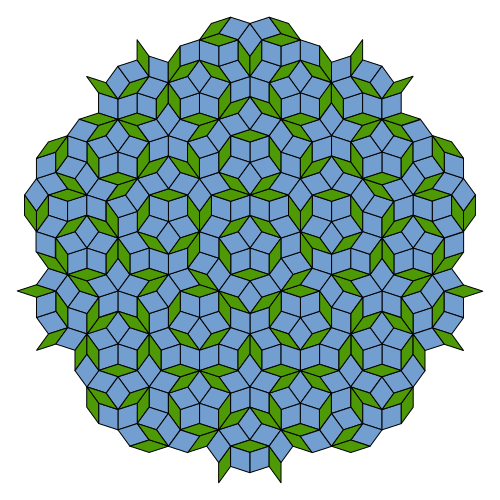So, in an earlier post, I spoke about a video I watched. It talks about Penrose Tiling.
Penrose tilings are fascinating mathematical patterns that can tile the plane infinitely without ever repeating themselves. They were discovered by mathematician Roger Penrose in the 1970s and have since captured the imagination of mathematicians, artists, and scientists alike.
Here are some key characteristics of Penrose tilings:
- Aperiodic: They do not have any repeating patterns, no matter how large a section you look at. This means that you can’t slide a section of the tiling to create a perfect match elsewhere.
- Made of two tiles: Penrose tilings are created using only two shapes, often called the “kite” and the “dart.” These tiles have specific proportions and cannot be combined to form a single shape.
- Fivefold symmetry: Despite their aperiodicity, Penrose tilings exhibit fivefold rotational symmetry. This means that the pattern can be rotated by 72 degrees five times and look exactly the same.
- Quasicrystals: The discovery of Penrose tilings helped to explain the existence of quasicrystals, which are materials with long-range order but no periodic structure.
Penrose tilings have found applications in a variety of fields, including:
- Art and design: Their unique patterns have been used in everything from floor mosaics to Escher-inspired prints.
- Mathematics and physics: They have been used to study aperiodic order and quasicrystals.
- Computer science: They have been used to develop algorithms for generating aperiodic tilings.
If you’re interested in learning more about Penrose tilings, there are many resources available online and in libraries. You can also find interactive tools that allow you to explore and create your own Penrose tilings.
So, I think the universe showed me this video because it relates to quasicrystals. Penrose tilings and quasicrystals share a fascinating relationship, although it’s important to understand both their similarities and differences:
Similarities:
- Non-periodic order: Both lack repeating patterns, unlike regular crystals. This means you can’t find a single unit that perfectly replicates the entire structure.
- Fivefold symmetry: Both exhibit fivefold rotational symmetry, meaning they look identical after rotating 72 degrees five times.
- Model for understanding: Penrose tilings serve as a simplified “toy model” for understanding the underlying principles of quasicrystals. They offer a visual and intuitive way to grasp how non-periodic order and fivefold symmetry can exist in physical materials.
Differences:
- Physical vs. mathematical: Quasicrystals are real physical materials with atoms arranged in a non-repeating pattern, while Penrose tilings are purely mathematical constructs.
- Limited correspondence: While Penrose tilings can help visualize certain aspects of quasicrystals, they don’t perfectly match the atomic structure of any known naturally occurring quasicrystal.
- Additional complexity: Quasicrystals often have more complex internal structures than Penrose tilings, involving different atomic types and arrangements.
Here’s a more nuanced view of their relationship:
- Penrose tilings as inspiration: The discovery of Penrose tilings in the 1970s challenged the traditional understanding of crystal structures and paved the way for the discovery of quasicrystals in the 1980s.
- Limited predictive power: While Penrose tilings provide a starting point, they can’t fully predict the properties and behavior of real-world quasicrystals.
- Active research area: Scientists continue to explore the connection between these two entities and use Penrose tilings as a tool to understand and design new types of materials with unique properties.
In summary, Penrose tilings offer a valuable tool for understanding the basic principles of quasicrystals, but it’s important to remember their limitations and not confuse them as perfect representations of these fascinating materials.
There is a reason the universe keeps pointing me to these aperiodic patterns. I will keep researching and figure out what the universe is trying to show me and keep updating here!
Discover more from Whispers of Insight
Subscribe to get the latest posts sent to your email.





